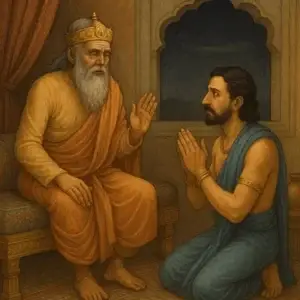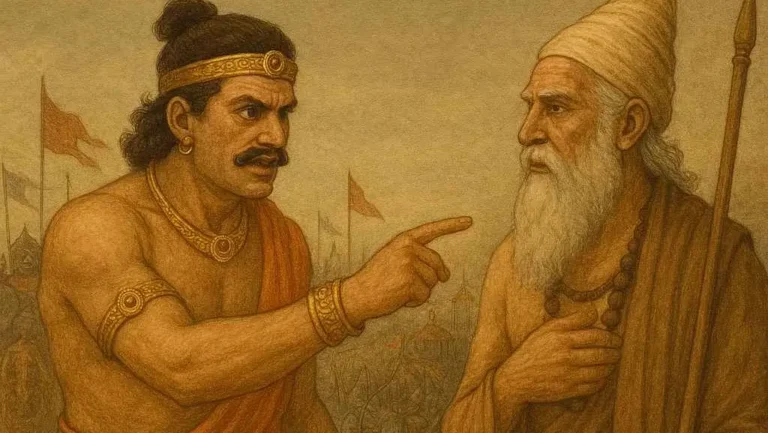What the First Verse of the Bhagavad Gita Reveals About Leadership and Relatives

Introduction
How many times have you picked up the Bhagavad Gita, only to finish it without truly grasping its depth? It’s a common experience—99% of Gita readers barely scratch the surface. This isn’t because the text is too difficult; rather, it’s because real understanding demands transformation. The first verse alone challenges us to rethink leadership, duty, and even our own identity. In this post, we’ll explore what Chapter 1, Verse 1 of the Bhagavad Gita teaches us about the qualities of a true leader and how these lessons apply to our lives.
The Verse in Focus: Bhagavad Gita Chapter 1, Verse 1
धृतराष्ट्र उवाच |
धर्मक्षेत्रे कुरुक्षेत्रे समवेता युयुत्सवः |
मामकाः पाण्डवाश्चैव किमकुर्वत सञ्जय ||1||
Transliteration:
dhṛitarāśhtra uvācha
dharma-kṣhetre kuru-kṣhetre samavetā yuyutsavaḥ
māmakāḥ pāṇḍavāśhchaiva kimakurvata sañjaya
Translation:
Dhritarashtra said: ”O Sanjay, after gathering on the holy field of Kurukshetra— the land of duty—desirous of battle, what did my sons and the sons of Pandu do?”
Understanding the Essence of Bhagavad Gita’s First Verse
The Bhagavad Gita begins not with the thoughts of the righteous Arjuna but with a question from King Dhritarashtra. Why? Because the Gita is not just a dialogue—it is a journey. And in this journey, we begin as Dhritarashtra and strive to evolve into Krishna’s wisdom.
Who Was Dhritarashtra?
Dhritarashtra was the blind king of Hastinapur and the uncle of the Pandavas. He was the father of the Kauravas, who stood against the Pandavas in the Kurukshetra war. Despite being a king, he displayed the traits of a weak leader—biased, attached, and driven by personal interests rather than righteousness.
This verse highlights two key flaws of Dhritarashtra that serve as lessons for us:
- A Leader Should Not Discriminate
At the time of the war, Dhritarashtra was a Chakravarti Samrat, meaning he ruled over many allied nations. Yet, in his question to Sanjay, he refers to the two sides as “my sons” and “the sons of Pandu”—implying partiality. A true leader does not divide people into “mine” and “others.” Instead, they treat everyone under their rule with fairness and justice. By separating his sons from his nephews, Dhritarashtra fails in his duty as a king. - Blind Attachment Corrupts Judgment
Dhritarashtra had vowed to care for the Pandavas after the death of their father, Pandu. But when his own sons committed heinous crimes—such as the attempted disrobing of Draupadi—he chose to protect them instead of upholding justice. This is a reflection of how we, too, often respect people based on tradition or age rather than their actions. True respect must be earned through righteousness, not just given by default.
Curiosity vs. Voyeurism
Dhritarashtra asks Sanjay about the battlefield, but not out of pure curiosity. He is not eager to learn; he is anxious about the outcome. There is a difference between curiosity and voyeurism:
- Curiosity arises from a pure desire to gain knowledge. It is the natural tendency of a being which is evidently visible in kids.
- Voyeurism stems from attachment, fear, and personal interest in hidden details. This is why many people love gossip, political drama, and spying into others’ lives—it gives them temporary satisfaction but no real wisdom.
Dhritarashtra’s question reflects the latter. He does not ask about Dharma (righteousness), nor about what is right or wrong. Instead, he merely wants to know what happened to his sons. This is a lesson for us to check our intentions when seeking information—are we genuinely learning, or are we indulging in unnecessary speculation?
Why Is Kurukshetra Called Dharmakshetra?
Kurukshetra was not just any battlefield—it was a Dharmakshetra, a land of Dharma. Historically, it was a sacred place where the early sages got the wisdom of the vedas and formed the foundation for Sanatan Dharma. The Vedas themselves provide guidance on what actions are righteous and what are not.
In the war, the Pandavas were fighting for justice—they had been wronged when their kingdom was taken away through deceit. The Kauravas, on the other hand, were fighting not for Dharma but for their personal ambitions. Interestingly, many of the Kaurava allies were not committed to their cause but were bound by duty, having given their word to fight alongside them. This highlights a deeper moral dilemma—should one honor a promise if it supports Adharma (injustice)?
The Battle Within Us
The war of Kurukshetra is not just a historical event—it represents an internal battle that we all fight. Just as Dhritarashtra is blind, we too are blind in many ways—blind to our own biases, attachments, and selfish desires. The journey of the Bhagavad Gita takes us from being like Dhritarashtra—selfish, fearful, and attached—to becoming like Krishna—wise, detached, and aligned with Dharma.
Key Takeaways from Bhagavad Gita 1.1
- A true leader does not discriminate – Justice must be served to all equally, without personal bias.
- Respect should be based on actions, not just relationships – We must evaluate people’s worthiness through their deeds, not merely their status.
- Pure curiosity leads to wisdom, while voyeurism leads to ignorance – Seek knowledge for enlightenment, not for personal gossip or fear.
- The battlefield of life is a test of righteousness – Kurukshetra represents the moral dilemmas we face, and how we choose to act defines our spiritual growth.
By understanding this first verse deeply, we begin the transformative journey of the Gita, moving from ignorance to wisdom, from attachment to detachment, and from being blind like Dhritarashtra to seeing the truth like Krishna.
Final Thoughts
The Bhagavad Gita is not just a religious text—it is a mirror that reflects our inner struggles and guides us toward the path of righteousness. By dissecting even its very first verse, we uncover profound lessons on leadership, justice, and self-awareness. As we proceed through the Gita, we will see how each verse builds upon this foundation, helping us evolve into our highest spiritual potential.
Are you ready to continue this journey? Stay tuned as we dive deeper into the teachings of the Bhagavad Gita, one verse at a time.


